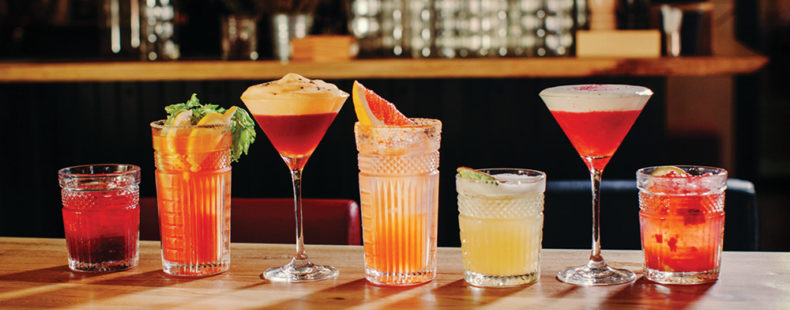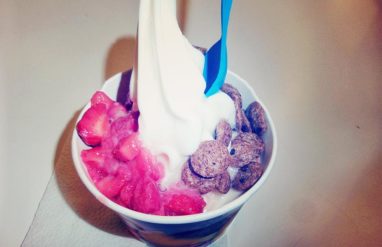An Anatomy Of Cocktail Names Through History
by John M. Cunningham
The cocktail renaissance of the 21st century, in which craft-cocktail bars have proliferated and classic cocktails are back in fashion, has proved that there is a true art to inventing and mixing drinks. But, what about naming them?
For some bartenders, bestowing a name upon one of their newly devised concoctions can be the most challenging part of the entire process. That’s because cocktail names have to do a lot of work on a bar’s menu. First of all, a name needs to pique a customer’s interest. Furthermore, it should convey something about the drink itself, maybe nodding to the cocktail’s provenance, highlighting a key ingredient, or even suggesting a mood that matches the style of drink.
And lastly, a cocktail name is an opportunity to signal its creator’s intentions. For the inventor of the drink, the name provides an extra opportunity for creativity and personal expression. A well-chosen name can also help to reinforce the overall aesthetic of the establishment.
It wasn’t always this complicated …
Nowadays, the word cocktail is applied to an enormous range of alcoholic mixed drinks, from sophisticated dry Martinis to fruity, umbrella-festooned Mai Tais. But, when the cocktail emerged in the United States around the turn of the 19th century, it was understood more narrowly. To drinkers of that era, a cocktail was, in its earliest-known written definition (1806, though the term itself is slighter older), a combination of “spirits of any kind, sugar, water, and bitters.” No more, no less.
The cocktail was thus only one type of mixed drink, distinguished from others such as punches, flips, juleps, sangarees, and toddies, each of which employed a different set of ingredients. With the recipe already more or less set, early cocktail names typically weren’t much more than a reference to the particular spirit called for: Whiskey Cocktail, Gin Cocktail, etc.
As for the word cocktail itself? Its origin has eluded many, but cocktail historian David Wondrich believes he’s cracked the case: “If you had an old horse you were trying to sell, you would put some ginger up its butt, and it would cock its tail up and be frisky. That was known as ‘cock-tail.’” The bitter and boozy drink, needless to say, was thought to be similarly stimulating.
As the Industrial Age took hold, the communal punch bowls that had provided for leisurely drinking sessions at taverns gave way to single-serving drinks such as the cocktail, which could be ordered individually and consumed quickly. In response to its growing popularity, American bartenders began to tinker with the cocktail’s formula, coming up with “fancy” and “improved” versions that added a bit of liqueur and/or absinthe to the mix. By the late 19th century, vermouth imported from Europe was making its way into cocktails, too.
To distinguish the original recipe from its proliferating variations, a retronym was adopted. What was once just a cocktail was now an old-fashioned cocktail, or an Old-Fashioned.
Per @DavidWondrich, this 1880 Chi Trib article is the earliest-known reference to the Old-Fashioned https://t.co/28d9zidxAX #cocktailsummit pic.twitter.com/eClsPwu3wA
— John M. Cunningham (@jmcunning) April 2, 2017
So how, then, were these new-fashioned cocktails named? As the term cocktail broadened to subsume other styles of mixed drinks, some names were formed simply by combining a spirit and a style, such as the Gin Fizz or the Whiskey Sour. However, variations on those styles inspired new names, which were inevitably less literal and more creative. Over time, a handful of naming conventions emerged, which continue to guide bartenders today.
Keeping it local
Several classic cocktails are named after the drinking establishment where they were created. The early 20th century, for instance, saw the creation of the La Louisiane (in New Orleans), the Pegu Club (Yangon/Rangoon), and the Hotel Nacional Special (Havana), each named after a site where the drink was served as a house specialty. While this convention is perhaps less common today, it has not entirely disappeared. Witness the Lost Lake, the signature cocktail at the Chicago tiki bar of the same name.
Likewise, some cocktail names have come from the city or region where the drink was birthed. The most famous of these is probably the Manhattan, one of those late-19th-century, vermouth-laden cocktails that took the world by storm. While its precise origins are disputed, it almost certainly originated somewhere in that New York City borough. The Singapore Sling, credited to Singapore’s legendary Raffles Hotel in the early 20th century, is another example.
Tribute acts
History has unfortunately forgotten many of the people behind the creation of classic cocktails. A select few, however, have been immortalized in drink names. One early example is New Orleans bartender Henry C. Ramos, who is remembered through his Ramos Gin Fizz. Another is London waiter John Collins, whose namesake 19th-century gin punch is now best known, for complicated reasons, as a Tom Collins cocktail. On the other side of the bar, the Negroni was supposedly named after an Italian count who liked his Americano aperitif with gin instead of soda water.
In the early 20th century, a popular trend was to name cocktails after celebrities outside the barroom. That era saw mixological tributes to movie stars of the day such as Mary Pickford, Charlie Chaplin, and Douglas Fairbanks, as well as to less-remembered figures such as Olympic fencer Lucien Gaudin.
While today’s bartenders occasionally reach for famous names of the past, cocktails named after contemporary celebrities are rare. More common are drinks that pay homage to popular culture through allusions to songs, movies, and other works of entertainment. Just as the Adonis and Rob Roy cocktails of the late 19th century were inspired by blockbuster Broadway shows of that era, a modern classic called the Paper Plane was named after a 21st-century hip-hop hit (M.I.A.’s “Paper Planes”).
Key ingredients
As fun as some of the above names are, hardly any of them convey what’s actually in the drink. To do that, a bartender might reference the ingredients directly (e.g., the Gin Basil Smash). Unsurprisingly, though, many prefer to take roundabout routes.
An early example of a cocktail with a name that isn’t simply the drink’s base spirit is the Jersey Cocktail. The name came from the fact that it was made with hard cider, which was once commonly produced in New Jersey. This sort of reference to a spirit’s geographic origin is also behind the vodka-based Moscow Mule and the recent Oaxaca Old-Fashioned, which mixes tequila and mezcal.
Puns on ingredients have also been fertile ground for cocktail names. For instance, because the Italian liqueur Cynar is made with artichokes, Cynar-laced drinks have acquired names such as the Art of Choke, Choke Hold, and Choke Artist.
Common senses
Once the various ingredients are mixed together, the drink’s appearance may suggest a name. The 19th-century Coffee Cocktail contains not a single drop of coffee, but its mixture of cognac, port, and egg is said to resemble a cup of joe. The Tequila Sunrise is characterized by luminous layers of orange and red in the glass, while the Dark ’n’ Stormy is a heady brew of dark rum and fizzy ginger beer.
On the other hand, some cocktail names are directly connected to how they taste. For example, a smoky flavor in a drink, perhaps from scotch or mezcal, might suggest the name Smoke Show. In fact, when it comes to certain flavors that may not appeal to all drinkers, putting a word like smoky or spicy or bitter in the name of the cocktail may be a good way to direct the drink to those who will best appreciate it.
Desired results
Finally, there is a long tradition of naming cocktails after their purported effects. Take the Corpse Reviver No. 2, the best-known variation in a series of Prohibition-era cocktails. Just as the word cocktail itself was meant to evoke a pick-me-up sort of drink, the name Corpse Reviver promises to arouse the spirit of the (perhaps hungover) person who drinks it. The Savoy Cocktail Book (1930) appends a warning, however: “Four of these taken in swift succession will unrevive the corpse again.” Also making its intentions plain is the tiki drink known as the Painkiller. In line with tiki culture’s aim to provide an escape from the everyday grind, this cocktail employs strong rum to cure one’s ails.
What about those provocatively named drinks of the 1980s, like the Sex on the Beach and the Sloe Comfortable Screw? Writer and bartender Michael Neff speculates that names like these “reflected what people wanted from a bar at the time. … The drinks simply helped to facilitate their good time.” The winking implication, perhaps, was that drinking provocatively named cocktails would eventually lead to, shall we say, memorable experiences.
Killer riffs
A major facet of the cocktail revival of the past couple of decades has been an increased awareness and interest in cocktail history. Bartenders and other enthusiasts have traced the origins and evolution of various drinks and sought to give credit where due. In creating new drinks, they have often drawn inspiration from the past by using an older drink as a template or starting point. When the new cocktail is a deliberate riff on the old, the name provides a way to respectfully acknowledge the pedigree. The simplest way to name a riff is to retain some part of the original’s name. For instance, a Manhattan made with a dark, bitter amaro instead of sweet vermouth is known as a Black Manhattan.
Another approach is based on the premise that the original drink and the new creation are members of the same cocktail family. The best-known example of this convention is a group of riffs on the Brooklyn, a classic cocktail composed of rye whiskey, dry vermouth, and two liqueurs. (The Brooklyn is itself a riff on the Manhattan.) The riffs retain the rye but modify the types of vermouth and liqueur to produce a unique drink in a similar style. In honor of their lineage, all of them are named after different Brooklyn neighborhoods: Red Hook, Bensonhurst, Greenpoint, Cobble Hill, Bushwick, etc.
Opting out
The online database Kindred Cocktails includes recipes for more than 6,000 cocktails. A few of these are different drinks with the same name, but most of the names are unique, and their online presence generally discourages bartenders from repurposing them. With so many potential names already taken, it’s no wonder that some bartenders are choosing to avoid the naming process.
Naren Young, bar director at Dante in New York, has said, “Bars can be confusing enough places already without having to give people a long list of drinks with nonsensical names ….” To help his customers feel more comfortable and confident when they order, Young populates his cocktail menus with mostly familiar drinks and styles. Other bartenders have taken names out of the equation altogether, feeling that they are too much of a distraction from the drink itself. Instead, numbers may be used.
For now, however, establishments that don’t name their cocktails are in the minority. As bartenders invent new drinks and beverage directors put together menus, the value of a name remains a top consideration.
More than a century later, many bar professionals implicitly follow the wisdom of William S. Adkins, author of The Practical Soda Fountain Guide (1911): “A good name will not carry a poor drink to success, but a good name attached to a good drink forms a strong combination.”
John M. Cunningham is a writer based in Chicago. For more than a decade, he worked at Encyclopaedia Britannica, where he served as its first Readers’ Editor and wrote articles on topics such as Justin Bieber and the National Spelling Bee. He is also a published crossword-puzzle constructor and a cocktail aficionado.














